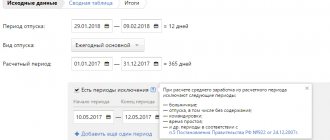Currently, fundamental changes are taking place in the field of pension provision for citizens of the Russian Federation. At the moment, there have been no changes in the field of compulsory pension insurance (OPI). Insurance premiums for compulsory health insurance also remain with the employer. They represent mandatory payments as a percentage of employee income and are not a fixed amount (except for individual entrepreneurs). The essence of the compulsory pension system is that when citizens reach retirement age, they are provided with a cash pension. Since 01/01/2017, the functions of insurance premiums have been performed by the Federal Tax Service.
Let's consider contributions to compulsory pension insurance in force in 2021.
Regulatory regulation
Federal Law “On Compulsory Pension Insurance in the Russian Federation” dated December 15, 2001 N 167-FZ regulates the basics of compulsory pension insurance
Tax Code of the Russian Federation Part 2 Chapter 34. Insurance premiums determines the obligation of employers to make payments under compulsory health insurance
Federal Law No. 27-FZ dated 04/01/1996 determines the mandatory registration of personal property assets
Order of the Federal Tax Service of Russia dated October 10, 2016 N ММВ-7-11/ [email protected] defines the reporting forms for contributions to compulsory pension insurance, its completion and submission
OPS Agreement
The OPS agreement stands for compulsory pension insurance agreement. It is a legal document between the insurer and the insured person, as a result of which one party transfers his funded pension to the control of the other party. This agreement is evidence that a citizen, a participant in the OPS system, becomes a client of a non-state pension fund (NPF).
Who has the right to enter into an OPS agreement?
All citizens who are officially employed in the territory of the Russian Federation, on account of which insurance premiums are made, are of legal age (younger than 1966), have the right to sign a compulsory insurance agreement with any non-state pension fund that is included in the DIA register.
After concluding a compulsory security agreement (sometimes also called a compulsory security certificate), the Pension Fund transfers all accumulated funds to the management of the non-state pension fund chosen by the person. In this case, the non-state pension fund assumes the right to invest the pension savings of its client and subsequently bring him income from investment activities. Only those non-state pension funds that have passed the inspection of the Central Bank and are included in the system of guaranteeing the rights of insured persons can invest in the compulsory pension insurance system. According to the new legislative conditions, all pension funds are joint-stock companies and can invest pension funds only in those financial instruments that are strictly regulated by law.
Registration as a payer of insurance premiums
From January 1, 2017, the Federal Tax Service takes into account all payers of insurance premiums.
Registration of organizations and individual entrepreneurs with the Federal Tax Service is carried out on the basis of the Unified State Register of Legal Entities and the Unified State Register of Entrepreneurs:
| organizations | at the location of the organization or its separate divisions |
| foreign non-profit organization | at the place of activity in the Russian Federation |
| IP | at his place of residence |
| the individual making payments (nanny, driver, etc.) | to any tax authority of your choice |
Currently, for the main category of insurance premium payers for the period up to 2021 inclusive, the Tax Code of the Russian Federation has established a tariff of insurance premiums for compulsory insurance in the amount of 22% of the maximum value of the base for calculating insurance premiums for this type of insurance and 10% above the maximum value of the base for calculating insurance premiums on OPS.
Deputy Director of the Department O.F. Tsibizova
Reduced insurance premium rates
In 2021, many previously provided benefits for individual entrepreneurs and legal organizations were cancelled. Thus, entrepreneurs engaged in work on patents were affected, as well as those who worked in the social and industrial fields, using a simplified taxation system.
Reduced tariffs remain for non-profit organizations involved in charity. In particular, this applies to those who carry out activities in the field of social services, conduct educational, outreach activities, and are engaged in science, culture or sports. They only have to transfer contributions to the Pension Fund, the amount of which does not exceed 20%.
Also, reduced tariffs are available to those organizations that operate in the field of information technology. These companies must meet the requirements specified in Article 427 of the Tax Code of the Russian Federation.
Article on the topic: Basic provisions of the federal law on OPS in the Russian Federation
If they fit the descriptions, then the insurance premium for them will have the following rates:
- OPS – 8%.
- Compulsory medical insurance – 4%.
- VNiM – 2%.
A significant reduction in contributions for compulsory medical insurance and VNIM is complemented by the opportunity not to make payments if the transferred funds exceed the limit values. Then OPS and VNIM are not accrued at the expense of the employer.
Knowledge of tax legislation is necessary for both employers and employees of their organizations. Payments under compulsory medical insurance, compulsory medical insurance, compulsory social insurance provide stability and guaranteed state support to the citizen, and for the employer they are a way to work honestly and openly. Understanding the principles of deduction of appropriate contributions can protect you from unpleasant overpayments in the future, and save money if the company qualifies for the reduced tariff program.
Payers of insurance premiums for compulsory health insurance
Payers are employers (organizations, individual entrepreneurs, individuals), who monthly calculate and pay contributions no later than the 15th day of the next month, after payments are made to individuals.
The amount of insurance premiums is calculated in rubles and kopecks and is calculated separately for compulsory health insurance, compulsory health insurance, compulsory medical insurance.
If the amount of expenses incurred for the payment of insurance premiums exceeds the total calculated amount, then the resulting difference is subject to offset by the Federal Tax Service against upcoming insurance or compensation payments.
OPS system
The compulsory pension insurance system includes the following participants:
- The policyholder is the Pension Fund. What is OPS in the Pension Fund? The Pension Fund of the Russian Federation is the central administrator in the compulsory pension insurance system. All contributions from employers are sent to it, and it already distributes these funds towards insurance and funded pensions. The Pension Fund does not manage pension savings of citizens. The extra-budgetary fund distributes savings among insurers, maintains personalized records of funds (for management companies and state management companies), and pays funded pensions (for management companies and state management companies).
- Insurers - NPF, UK, GUK. Insurers in the OPS system are non-state pension funds, management companies and the state management company (Vnesheconombank). These structures are engaged in investing pension savings, according to the personal choice of citizens.
- The insured person is a citizen. The owner of pension savings is an insured person if he has chosen an insurer for his savings or a “silent one” if he has not written an application to transfer funds to a non-state pension fund or management company.
Base for calculating contributions to compulsory pension insurance
The base is calculated as the amount of payments accrued by the employer-payer of insurance premiums, with the exception of amounts not subject to taxation (benefits, compensation, financial assistance, etc.), the accrual base is determined separately in relation to an individual individually at the end of each month on an accrual basis with beginning of the year.
The basis for calculating insurance premiums for compulsory health insurance has a limitation, after which insurance premiums paid when calculating at the rate of insurance premiums for compulsory health insurance in the amount of 22% are subject to payments in excess of the limit in the amount of 10% of the excess.
The maximum value of the base is subject to indexation annually from January 1 of the corresponding year based on the average salary in the Russian Federation.
The maximum base for calculating contributions to compulsory health insurance in 2021 is 1,021,000 rubles.
The insurance premium rate in general in 2021 is 30%:
- 22% – for OPS within 1,021,000 rubles. and 10% above the base
- 2.9% – on OSS
- 5.1% for compulsory medical insurance
What is the procedure for paying insurance premiums?
According to the Tax Code of the Russian Federation, insurance premiums for compulsory health insurance must be transferred on the 15th of each month. If the 15th falls on a holiday or weekend, then the deadline for paying contributions is moved to the first working day. If for any reason a company or individual entrepreneur did not manage to transfer the insurance premium on time, then it will be forcibly collected from them by the regulatory body.
The tax base is formed as follows:
- basic tariff – 22%;
- additional tariff – 10%; accrued if the established limit is exceeded;
- contributions for compulsory medical insurance – 5.1%.
It is worth noting that the maximum amount of the insurance base from which insurance fees must be paid is 796 thousand rubles.
The procedure for calculating insurance premiums for compulsory health insurance
To determine the base for contributions to compulsory pension insurance, all payments and benefits to employees are taken into account, except:
- state benefits
- compensation
- travel expenses within normal limits
The calculation is made on an accrual basis. Until the payment amount reaches 1,021,000 rubles. (in 2021) 22% is accrued on OPS, above this amount - 10%. Calculation of contributions - in rubles and kopecks (without rounding).
The transferred contributions are written off as expenses.
What are ambiguous terms?
Before you find out the decoding of the abbreviation in question, it is worth clarifying why it belongs to the category of words that are characterized by ambiguity.
This abbreviation illustrates the ability of names to have not one, but several lexical meanings at once.
In the case of terms (a specialized word/phrase that means a specific concept and is used within a certain environment), polysemy is characteristic of them only due to homonymy.
This means that there are several parallel phenomena whose names look identical. However, they are in no way related to each other, and their similarity is the result of an ordinary coincidence. The existence of many options for deciphering the abbreviation OPS is just that case.
Payment of insurance premiums for compulsory health insurance in 2021
Payments are transferred by payment order, where the budget classification code must be indicated in field 104. Contributions to the Federal Tax Service in 2021 are paid for each type of insurance separately.
The BCC for contributions to OPS is indicated - 1821020211061010160, regardless of whether it is the main payment or penalties and fines
Payment of contributions is made monthly no later than the 15th day of the following month, and reporting is provided quarterly.
Calculation of insurance premiums (DAM) in 2021 is provided in the form approved by the Federal Tax Service of the Russian Federation dated October 10, 2016 No. ММВ-7-11 / [email protected] , the deadline for which, according to Article 431 of the Tax Code of the Russian Federation, is the 30th day following the reporting period month (for example, for 9 months of 2021 - 10/30/2021, for a year - 01/30/2021).
The RSV is represented by a title page and 3 sections with appendices. If the organization has more than 25 employees, then the DAM is submitted electronically, if there are 25 or fewer, it can be submitted in paper form (at the discretion of the employer). If an error is found in the DAM, then 5 days are given for correction (10 days for paper reporting). The control ratios of the DAM indicators were approved by order of the Federal Tax Service of Russia dated October 10, 2016 No. ММВ-7-11/ [email protected]
Important! Payers who do not pay amounts to individuals: individual entrepreneurs, lawyers, mediators, notaries and other persons engaged in private practice), except for the heads of public utility services, are not required to fill out and submit the DAM.
OPS: what is this?
What does the abbreviation OPS mean? The definition of the abbreviation OPS is presented below. Each resident of Russia, thanks to this insurance, receives a unique personal number code. This code allows you to control all payments made by the Pension Fund.
Since 2002, the pension system of the Russian Federation has undergone dramatic changes: the distribution system was replaced by a distribution-saving system. Now employers pay insurance premiums for compulsory health insurance as follows:
| Citizens born from 1967 to 2015 | Can choose: · or the formation of only an insurance pension; · or formation of an insurance + funded pension in parallel, by choosing a non-state PF |
| Citizens under 23 years of age who went to work for the first time | Can choose the type of pension provision within five years from the date of first receipt of insurance money |
You are only allowed to manage the funded part of your pension. This is the amount that accumulates before “freezing”: a person makes a decision to transfer his pension savings to the Non-State Pension Fund (NPF), or to save money in the Pension Fund. The transition can be urgent/early. You can read more about compulsory pension insurance here.
Regulatory framework and structure of public safety organizations
The main regulatory regulator for the development of compulsory pension insurance is Federal Law No. 167 of 2001. Article No. 1 of this law provides a breakdown of the compulsory pension system, with the help of which the state forms sources of financing for future pensions. The legislative framework of the OPS includes:
The current organization of the OPS includes three categories of participants:
| №/№ | Subjects of OPS | Explanations |
| 1. | Policyholder | The Pension Fund itself plays this role. The fund plays the function of the chief administrator involved in the distribution of contributions (starting from 2017, the collection of budget money is carried out by the tax office). In addition, the Pension Fund maintains personal records and collects documents for the purpose of assigning pensions. |
| 2. | Insurer | This role is performed by: · non-state PF · state-appointed management companies |
| 3. | Insured person | This definition means a citizen for whom the policyholder regularly makes insurance payments |
Related article: Features of voluntary pension insurance
What does such an OPS system provide? The policyholder receives all information on potential/current pensioners. The insured person has the right to claim payment, but only after reaching a certain age limit or the occurrence of insured events.
What is the procedure for paying insurance premiums?
The Tax Code requires that insurance premiums for compulsory health insurance be transferred on the fifteenth of each month. If this date falls on a weekend/holiday, then contributions must be received on the first working week.
Attention! When an employer does not make timely payments for any reason, then the regulatory body compulsorily collects the insurance premium from him.
Important note! The maximum amount of the insurance base from which insurance premiums should be paid is 796 rubles.
Procedure for calculating insurance premiums
The introduction of an insurance premium accounting system is carried out for each type of insurance separately. Each contribution requires the use of a payment document indicating the treasury account + BCC.
Insurance premiums for compulsory insurance must be paid at a banking organization. If there is no bank (village, village), transfer of insurance payments is made through the cash desk of the local administration/post office. Contributions must be paid in the amount of 100%, without division into insurance/savings parts.
How are contributions to compulsory pension insurance calculated?
Accounting for contributions occurs as follows: An individual account has been opened for each citizen at the Pension Fund. Each account has a SNILS number. Insurance premiums paid by employers are deposited into this account. On the basis of this, in the future, the amount of the pension will be calculated.
Today SNILS is of great importance. It must be issued to a person upon his first application to the Pension Fund, or upon the start of his work activity.
Pension Fund or Non-State Pension Fund: choice
The meaning of a funded pension lies in the possibilities of investing it in order to make a profit. In this regard, every potential retiree must find the optimal way to invest their savings. The most common market instrument for this is the NPF (non-state fund).
Attention! Before trusting money to a non-state pension fund, you need to carefully weigh the pros/cons. The transfer of the funded part of the NPF will mean that this structure assumes full responsibility for the further payment of pensions to the policyholder.
The choice of NPF is purely individual. No one has the right to force a person to move from the Pension Fund to the Non-State Pension Fund. Only the occurrence of three situations will indicate the inevitability of such a transition:
- When the license was revoked.
- When the contract expires.
- If the policyholder dies.
Article on the topic: Features of professional pension insurance in the Republic of Belarus
OPS: how does the system work?
The Russian system of financial support for old age, as well as for receiving a disability group / loss of a breadwinner, operates according to the following general algorithm:
- All employers automatically go through the registration procedure with the Pension Fund immediately after registering with the tax authorities (Federal Law No. 167, clause 1, part 1).
- Individuals sign employment agreements, receiving the status of “insured”: that is, citizens entitled to receive financial benefits for old age, disability, etc.
- Insurers, according to the OPS system, pay insurance premiums to the Federal Tax Service every month for all their employees. The amount of payments is 22% of the salary, unless otherwise provided by Chapter No. 34 of the Tax Code of the Russian Federation.
- The deposited insurance money is displayed on individual accounts in the personal accounting system. Each citizen can count on the formation of a personal “dossier” informing about what contribution the insured person was able to make to the system. Accordingly, how much money a person will receive when an insurance claim occurs.
- The budget “basket” of the Pension Fund is formed from money from insurance premiums and other sources of financing.
- Citizens who fall under the insurance claim apply to the insurer (PFR) with a request to assign them an established pension (it can be insurance, funded, etc.). This pension will be paid from the Pension Fund funds, which were generated in the manner described above.
Attention! Citizens are registered in the OPS automatically after all the conditions adopted by law that give the status of “insured persons” have been fulfilled. In this case, you do not need to write any statements.
System principles
The text of Federal Law No. 167 does not indicate the principles of compulsory social insurance, however, they are similar to any other type of social insurance:
Overpaid contributions to compulsory health insurance
Payers of contributions may offset or refund overpaid amounts or contributions, penalties and fines.
The overpaid amount can be offset:
- towards upcoming payments
- to pay off debts on penalties and fines
- returned to the payer
Offset against upcoming payments or penalties and fines is carried out independently by decision of the Federal Tax Service, which cannot prevent the payer from submitting an application in written or electronic form for offset of amounts.
Also, overpayments of compulsory medical insurance contributions can be offset against compulsory health insurance and vice versa (but not compulsory health insurance).
To return contributions overpaid, the payer submits an application (can be submitted within 3 years from the date of payment) and the amount is returned within 1 month after receipt of the application. But if there is a debt on penalties and fines, a refund can be made only after they are offset against its repayment.
Answers to common questions
Question No. 1 : What tariffs for compulsory security contributions are applied by FEZ participants in the territories of Crimea and Sevastopol?
Answer : In the territories of Crimea and Sevastopol, for 10 years from the date they received FEZ status, the insurance tariff is 7.6% (including for compulsory insurance - 6.0%).
Question No. 2 : Should insurance premiums be charged for travel expenses for which the employee has not reported?
Answer : If the employee agrees to return the amount of travel allowances, then they are deducted from the salary, if not, then personal income tax and insurance contributions must be calculated. If the money is returned independently or through the court, then an updated DAM is submitted.








